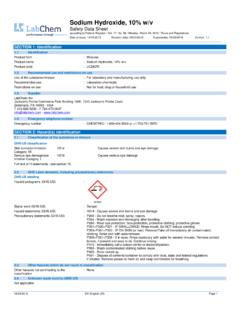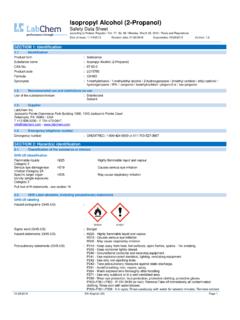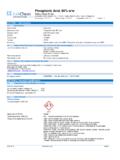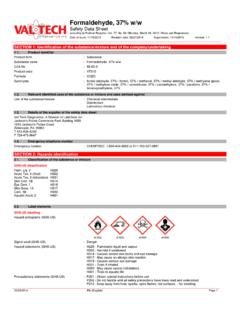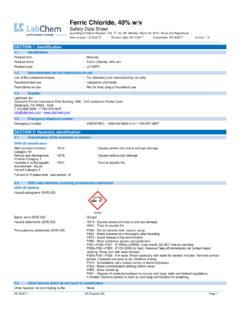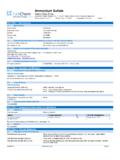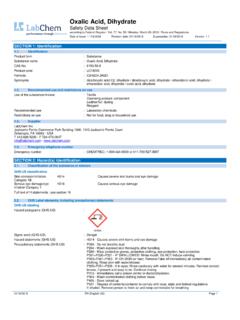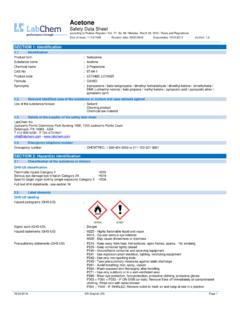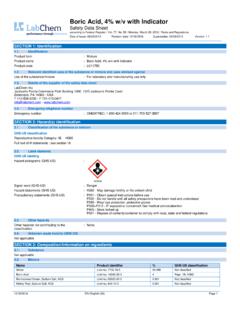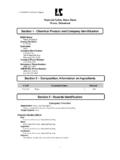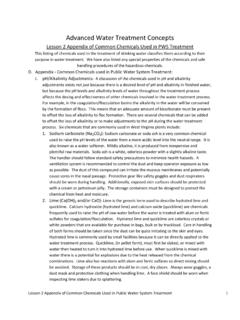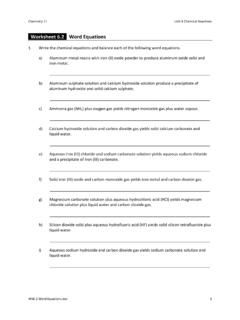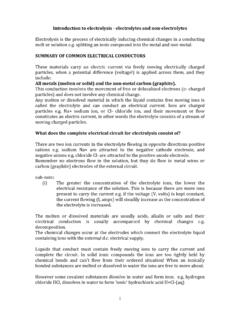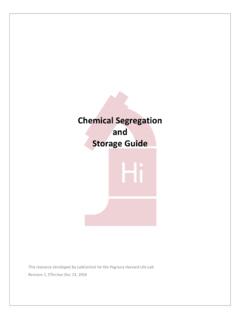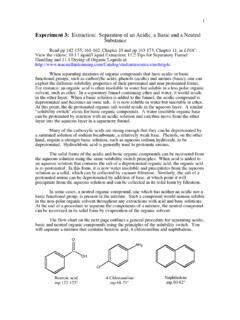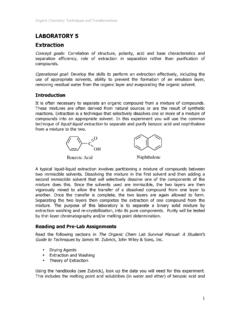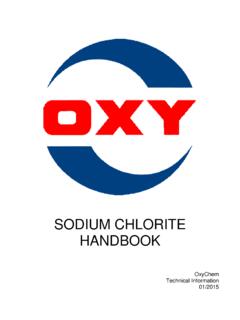Transcription of Sodium Hydroxide, 1.0N (1.0M)
1 Sodium hydroxide , ( ). Safety Data Sheet according to Federal Register / Vol. 77, No. 58 / Monday, March 26, 2012 / Rules and Regulations Issue date: 10/18/2013 Revision date: 07/22/2020 Supersedes: 04/03/2018 Version: SECTION 1: Identification Identification Product form : Mixtures Product name : Sodium hydroxide , ( ). Product code : LC24350. Recommended use and restrictions on use Use of the substance/mixture : For laboratory and manufacturing use only. Recommended use : Laboratory chemicals Restrictions on use : Not for food, drug or household use Supplier LabChem, Inc. 1010 Jackson's Pointe Ct.
2 Zelienople, PA 16063 - USA. T 412-826-5230 - F 724-473-0647. - Emergency telephone number Emergency number : CHEMTREC: 1-800-424-9300 or +1-703-741-5970. SECTION 2: Hazard(s) identification Classification of the substance or mixture GHS US classification Skin corrosion/irritation Category 1B H314 Causes severe skin burns and eye damage Serious eye damage/eye irritation Category 1 H318 Causes serious eye damage Full text of H statements : see section 16. GHS Label elements, including precautionary statements GHS US labeling Hazard pictograms (GHS US) : Signal word (GHS US) : Danger Hazard statements (GHS US) : H314 - Causes severe skin burns and eye damage Precautionary statements (GHS US) : P260 - Do not breathe mist, spray, vapors.
3 P264 - Wash exposed skin thoroughly after handling. P280 - Wear eye protection, face protection, protective clothing, protective gloves. P301+P330+P331 - IF SWALLOWED: Rinse mouth. Do NOT induce vomiting. P303+P361+P353 - IF ON SKIN (or hair): Remove/Take off immediately all contaminated clothing. Rinse skin with water/shower. P305+P351+P338 - IF IN EYES: Rinse cautiously with water for several minutes. Remove contact lenses, if present and easy to do. Continue rinsing. P310 - Immediately call a poison center or doctor/physician. P363 - Wash contaminated clothing before reuse. P405 - Store locked up.
4 P501 - Dispose of contents/container to comply with local, state and federal regulations. P304+P340 - IF INHALED: Remove person to fresh air and keep comfortable for breathing. Other hazards which do not result in classification Other hazards not contributing to the : None. classification Unknown acute toxicity (GHS US). Not applicable 07/22/2020 EN (English US) Page 1. Sodium hydroxide , ( ). Safety Data Sheet according to Federal Register / Vol. 77, No. 58 / Monday, March 26, 2012 / Rules and Regulations SECTION 3: Composition/Information on ingredients Substances Not applicable Mixtures Name Product identifier % GHS US classification Water (CAS-No.)
5 7732-18-5 Not classified Sodium hydroxide (CAS-No.) 1310-73-2 Skin Corr. 1A, H314. Eye Dam. 1, H318. Aquatic Acute 3, H402. Full text of hazard classes and H-statements : see section 16. SECTION 4: First-aid measures Description of first aid measures First-aid measures general : Never give anything by mouth to an unconscious person. If you feel unwell, seek medical advice (show the label where possible). First-aid measures after inhalation : Remove victim to fresh air and keep at rest in a position comfortable for breathing. Immediately call a poison center or doctor/physician.
6 First-aid measures after skin contact : Immediately call a poison center or doctor/physician. Remove/Take off immediately all contaminated clothing. Rinse skin with water/shower. First-aid measures after eye contact : Rinse cautiously with water for several minutes. Remove contact lenses, if present and easy to do. Continue rinsing. Immediately call a poison center or doctor/physician. First-aid measures after ingestion : Do NOT induce vomiting. Immediately call a poison center or doctor/physician. Rinse mouth. Most important symptoms and effects (acute and delayed). Potential Adverse human health effects and : Based on available data, the classification criteria are not met.
7 Symptoms Symptoms/effects : Causes severe skin burns and eye damage. Symptoms/effects after inhalation : Coughing. Irritation of the respiratory tract. Irritation of the nasal mucous membranes. Symptoms/effects after skin contact : Caustic burns/corrosion of the skin. Symptoms/effects after eye contact : Causes serious eye damage. Symptoms/effects after ingestion : Abdominal pain. Bleeding of the gastrointestinal tract. Burns to the gastric/intestinal mucosa. Nausea. Possible esophageal perforation. Symptoms/effects upon intravenous : Not available. administration Chronic symptoms : Not available.
8 Immediate medical attention and special treatment, if necessary Obtain medical assistance. SECTION 5: Fire-fighting measures Suitable (and unsuitable) extinguishing media Suitable extinguishing media : Carbon dioxide. Dry powder. Water spray. Foam. Sand. Unsuitable extinguishing media : Not available. Do not use a heavy water stream. Specific hazards arising from the chemical Fire hazard : Not flammable. Explosion hazard : Not available. Reactivity in case of fire : Reacts with (some) metals: release of highly flammable gases/vapours (hydrogen). Thermal decomposition generates : Corrosive vapors.
9 Special protective equipment and precautions for fire-fighters Firefighting instructions : Use water spray or fog for cooling exposed containers. Exercise caution when fighting any chemical fire. In case of fire, stop leak if safe to do so. When cooling/extinguishing: no water in the substance. Prevent fire-fighting water from entering environment. Protection during firefighting : Do not enter fire area without proper protective equipment, including respiratory protection. Other information : Not available. 07/22/2020 EN (English US) 2/9. Sodium hydroxide , ( ). Safety Data Sheet according to Federal Register / Vol.
10 77, No. 58 / Monday, March 26, 2012 / Rules and Regulations SECTION 6: Accidental release measures Personal precautions, protective equipment and emergency procedures General measures : Eliminate ignition sources. Ensure adequate ventilation. Wear self-contained breathing apparatus when entering area unless atmosphere is proved to be safe. For non-emergency personnel Protective equipment : Wear chemically protective gloves, lab coat or apron to prevent prolonged or repeated skin contact. Emergency procedures : Wash contaminated clothes. Evacuate unnecessary personnel. Keep containers closed.
